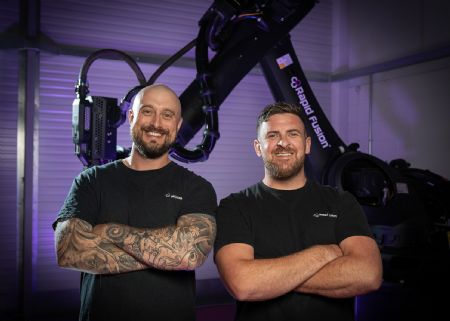
The team at Phoenix Analysis and Design Technologies in Arizona
Rapid Fusion is looking to break into the US market after signing a new reseller agreement with a US additive manufacturing (AM) specialist. The Exeter-based company, which employs 10 people at its ‘state of the art’ Skypark demonstration centre, has joined forces with
Phoenix Analysis and Design Technologies (PADT) to sell its robotic AM systems to customers in the aerospace and defence sectors.
Rapid Fusion believe there are almost £2 million worth of opportunities to be enjoyed in the first year across the Western half of the country and have earmarked its Apollo, Zeus and Medusa solutions as offering significant time and cost savings compared to existing models. The company will initially target PADT’s existing customer base, while leveraging the US firm’s unrivalled technical knowledge, manufacturing networks and 30-year track record to make inroads into a market that is estimated to be worth $619.3 million globally by 2030.
Significant successJake Hand, Rapid Fusion’s managing director, said: “We have had significant success disrupting the large format (LAFM) arena in the UK and Europe and felt it was time to roll it out in the USA – a sector that is the largest in the world for our technology. We needed to find the right partner who not only understood our values and our products but also had immediate access to customers who would benefit from our solutions. Initial conversations with PADT founder Rey Chu got us really excited, and we are delighted to sign the deal that makes the company our first US reseller.
“PADT will have access to our full portfolio, including Apollo (a full turnkey 3-D robotic printer), Zeus (a 3-D printing robot that incorporates a unique CNC milling capability) and Medusa. The latter is a real LFAM gem and is three-times faster than conventional machines, twice as accurate and promises to reduce training and maintenance costs by 30%.”
 Pictured left: Rapid Fusion’s CEO Jake Hand and CTO Martin Jewell
Pictured left: Rapid Fusion’s CEO Jake Hand and CTO Martin JewellPADT has already committed to recruiting and training up a dedicated Rapid Fusion sales specialist, with a longer-term plan being to host several of the firm’s robots at its headquarters at the
Arizona State University Research Park in Tempe. It will use its business-to-business marketing and sales function to communicate with prospective customers, initially in aerospace and defence and then moving into automotive, construction and medical.
Interested parties will engage in an initial needs discovery conversation that will proceed to an application analysis and pilot proposal. Once agreed, the project will be executed with the goal of building a business case and ROI (return on investment) justification using jointly defined success metrics, employing actual customer data. Based on the findings of the pilot, a commercial proposal will then be developed for a production system purchase, system implementation, training and post-sale support.
Complementary and disruptiveRey Chu, a principal and 3-D printing pioneer at PADT, said: “Rapid Fusion’s pellet extrusion and robotic arm-based 3-D printing systems offer a complementary and disruptive alternative to our current AM offerings, enabling new applications in aerospace, construction, motor vehicles, and tooling. With a 100,000-strong marketplace on the West coast alone there is so much potential for us to disrupt the US marketplace, and we are looking forward to accelerating the UK firm’s presence here. The key will be getting the first customers on board and then we have a fantastic test case to entice more companies to adopt the technology.”
Mr Hand concluded: “The USA is the largest country globally for AM and a strategic part of our expansion plans. We conservatively forecast around £2 million of revenue in the first 12 months and then, over time, for it to grow to become our largest territory.”
In addition to international expansion, Rapid Fusion has also recently launched a new AI ‘print assistant’ that will help enhance the performance of its groundbreaking robotic AM systems. Its team of developers have leveraged the power of artificial intelligence (AI) to optimise solutions for customers 3-D printing complex components for the automotive, aerospace, construction, medical and military sectors.
After eight months of coding, troubleshooting and various live tests, ‘Bob (Base of Build)’ is now being rolled out to existing clients and is promising to optimise its robots by making them easier to use, providing greater operator control and ensuring less downtime through preventative maintenance.